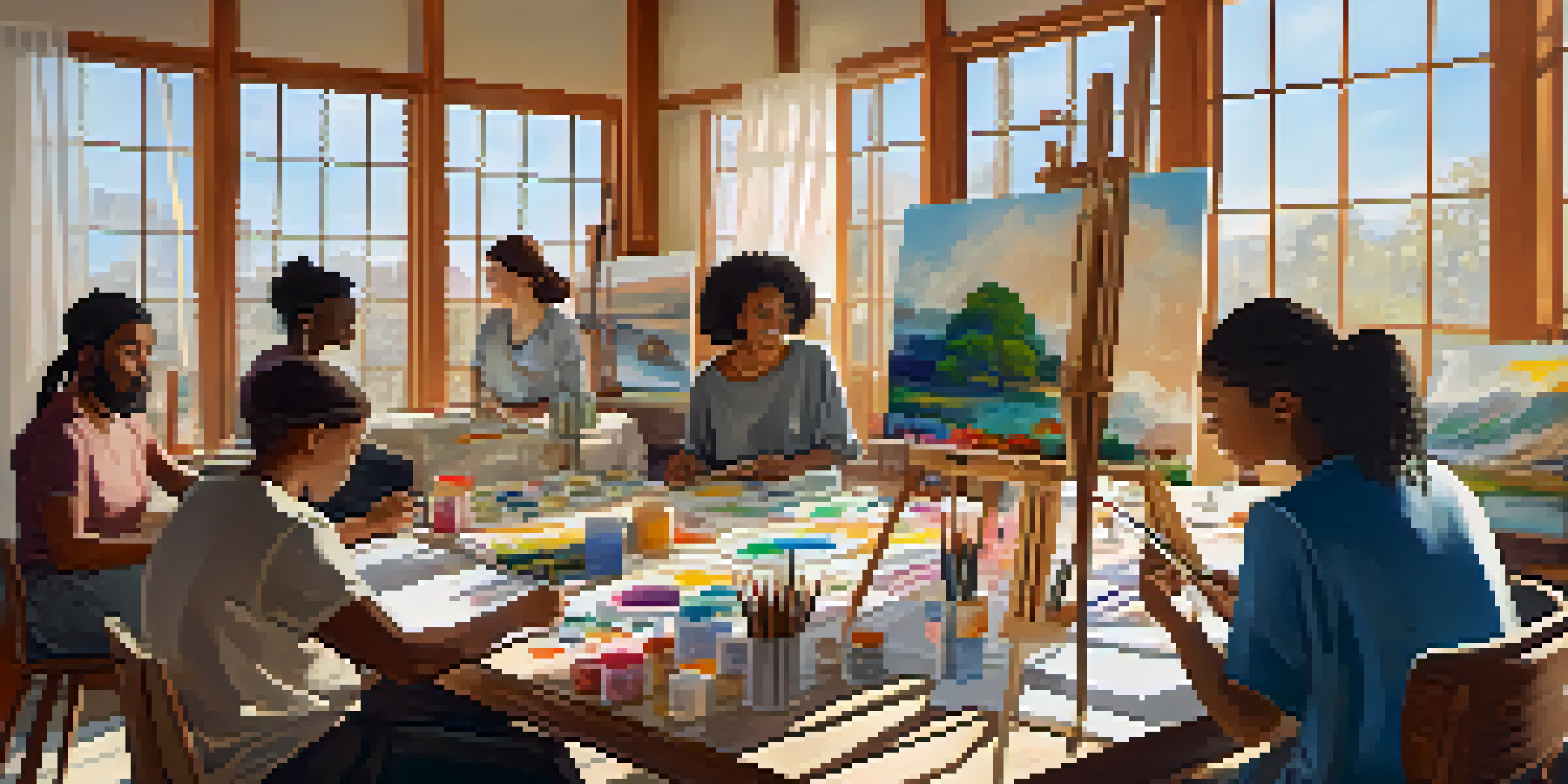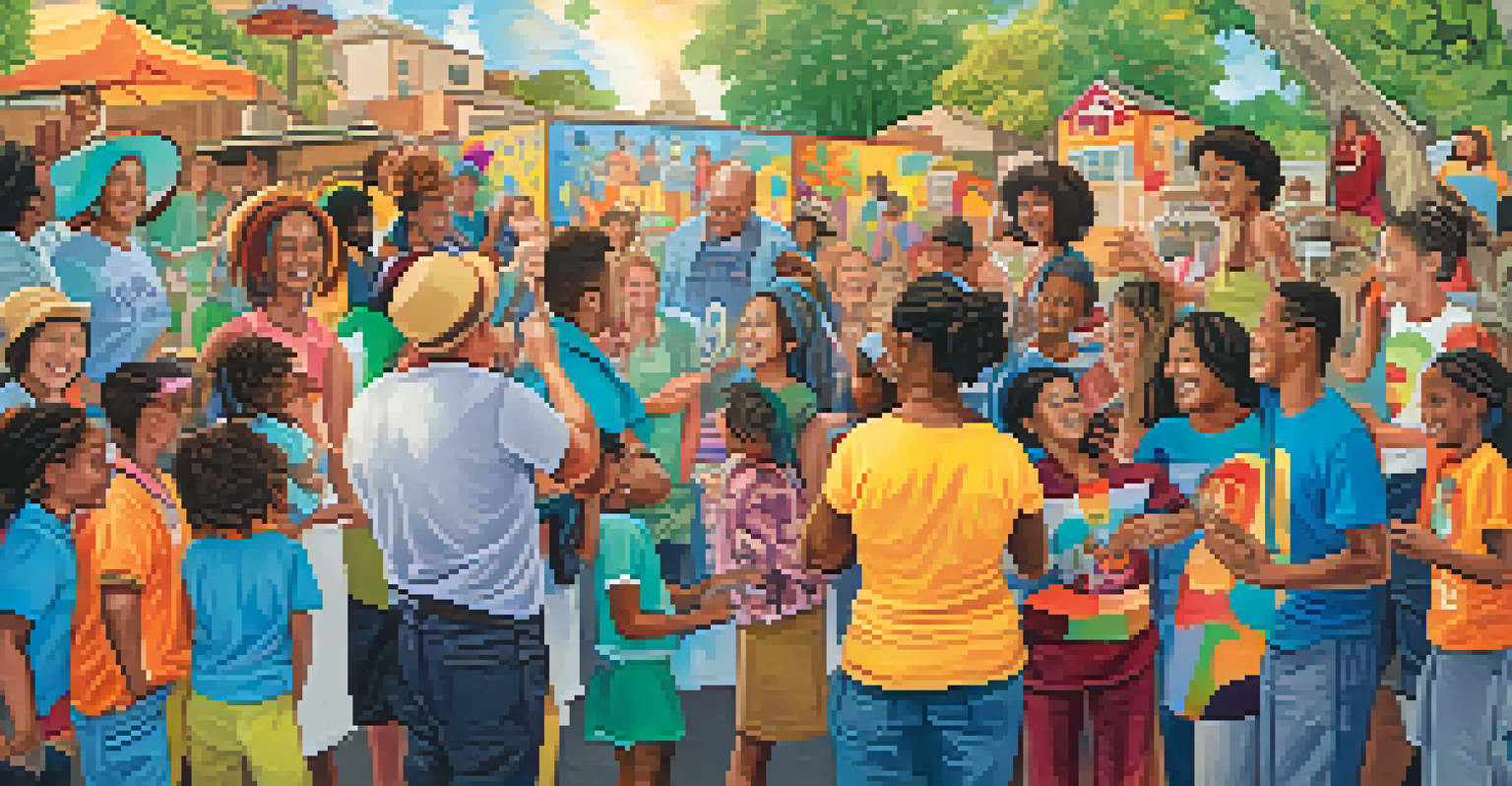The Influence of Art Therapy on Social Healing and Resilience

Understanding Art Therapy and Its Purpose
Art therapy is a therapeutic practice that uses creative expression as a means to improve mental health and emotional well-being. By encouraging individuals to create art, whether through painting, drawing, or other mediums, it allows for a unique form of self-expression. This practice is particularly effective for those who may struggle to articulate their feelings verbally, offering a safe space to explore complex emotions.
Creativity takes courage.
The purpose of art therapy goes beyond just creating beautiful pieces; it aims to facilitate healing and personal growth. It can help individuals process trauma, reduce anxiety, and build self-esteem. By tapping into creativity, participants can transform their pain into something tangible, which can be incredibly empowering.
Additionally, art therapy often fosters a sense of community and connection among participants. As individuals share their creations and stories, they can find common ground, leading to supportive relationships that enhance the healing process.
Art Therapy's Impact on Community Healing
In communities affected by trauma, whether from violence, natural disasters, or systemic issues, art therapy can play a crucial role in collective healing. Group art therapy sessions provide a platform for people to express their experiences, fostering dialogue and understanding among participants. This shared creative process helps to break down barriers and facilitate communication.

When individuals come together to create art, they often discover they are not alone in their struggles. This sense of shared experience can reduce feelings of isolation and promote empathy within the group. For example, survivors of a natural disaster may find solace in expressing their grief through art, while simultaneously supporting each other through the healing journey.
Art Therapy Enhances Emotional Healing
Art therapy uses creative expression to help individuals process emotions, reduce anxiety, and promote personal growth.
Moreover, community art projects can serve as a powerful tool for social change. By collectively creating art that reflects their experiences, communities can raise awareness and advocate for their needs, ultimately leading to resilience and recovery.
Building Resilience Through Creative Expression
Resilience is the ability to adapt and bounce back from adversity, and art therapy can significantly contribute to this vital skill. Engaging in creative processes allows individuals to explore their emotions and build coping strategies in a safe environment. This exploration helps them to confront challenges rather than avoid them, paving the way for personal growth.
Art is not what you see, but what you make others see.
For instance, a person dealing with grief may use art to externalize their feelings, transforming their pain into a visual narrative. This act of creation not only provides relief but also cultivates resilience as they learn to navigate their emotions. The process of creating and reflecting on their art encourages individuals to develop a deeper understanding of their experiences.
Furthermore, the skills learned through art therapy—such as problem-solving, critical thinking, and emotional regulation—can be applied to everyday life. As individuals practice these skills in a supportive setting, they gain confidence in their ability to handle future challenges, ultimately enhancing their resilience.
Art Therapy in Diverse Populations
Art therapy is versatile and can be tailored to meet the needs of various populations, including children, veterans, and those with mental health challenges. Each group may face unique struggles, and art therapy offers a way to address these issues through creativity. For example, children may use art to express feelings they cannot yet articulate, while veterans might find solace in creating art that reflects their experiences.
By adapting the therapeutic approach to fit different needs, art therapists can create a more inclusive environment. This flexibility is vital for reaching individuals who may feel uncomfortable in traditional talk therapy settings. The non-verbal nature of art allows for a more accessible means of communication for those who may feel stigmatized or hesitant to share their thoughts openly.
Community Healing Through Art
Group art therapy fosters dialogue and connection among individuals, helping communities heal collectively from trauma.
Moreover, inclusive art therapy practices promote cultural sensitivity and understanding. By incorporating culturally relevant themes and materials, therapists can create a more meaningful experience that resonates with participants, further enhancing the healing process.
The Science Behind Art Therapy's Effectiveness
Research supports the effectiveness of art therapy in promoting emotional and psychological well-being. Studies have shown that engaging in creative activities can reduce symptoms of anxiety, depression, and PTSD. The act of creating art stimulates the brain's reward system, releasing endorphins that promote feelings of happiness and relaxation.
Furthermore, art therapy can facilitate brain connectivity and cognitive functioning. When individuals engage in artistic activities, they exercise both the left and right hemispheres of the brain, fostering a balance between logic and creativity. This holistic approach can lead to improved overall mental health, enabling individuals to cope more effectively with life's challenges.
In addition to individual benefits, the collective impact of art therapy on communities has been documented. Community art initiatives have been shown to enhance social cohesion and foster a sense of belonging, ultimately contributing to a healthier and more resilient society.
Integrating Art Therapy into Traditional Treatment Plans
As the benefits of art therapy become more recognized, there is a growing movement to integrate it into traditional treatment plans for mental health. Combining art therapy with conventional therapeutic approaches can create a more holistic treatment experience. This integration can provide a more comprehensive understanding of a patient's needs, leading to more effective interventions.
For instance, a therapist may combine cognitive-behavioral therapy (CBT) with art therapy techniques to help clients visualize their thoughts and feelings. This can provide a valuable bridge between the cognitive and emotional aspects of healing. By incorporating art, therapists can engage clients in ways that resonate with them, enhancing their overall experience.
Resilience Built Through Creativity
Engaging in art therapy equips individuals with coping strategies and problem-solving skills that enhance resilience in everyday life.
Moreover, as healthcare providers become more aware of the importance of mental health, incorporating art therapy into treatment plans can help reduce stigma. It highlights the significance of creative expression in healing and encourages individuals to seek help without fear of judgment.
Future Directions for Art Therapy Research and Practice
Looking ahead, the field of art therapy is poised for growth and innovation. As more research emerges, practitioners can refine their techniques and approaches based on evidence-based practices. This ongoing exploration will enhance the credibility and effectiveness of art therapy as a legitimate therapeutic modality.
Additionally, the rise of technology offers exciting opportunities for art therapy practice. Virtual art therapy sessions and digital art tools can make therapy more accessible to individuals who may not have traditional resources. This adaptability ensures that art therapy can reach diverse populations, regardless of geographical limitations.

Finally, as awareness of mental health continues to evolve, there is potential for art therapy to play a more significant role in preventative care. By promoting creative expression as a fundamental aspect of mental health, communities can foster resilience and support emotional well-being before challenges arise.